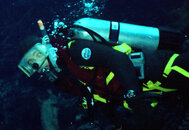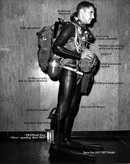- Just for you Bond , James Bond
from my files...
The Big Barreled Snorkel
The big barreled snorkel was developed many years ago in the garages and workshops in Southern California by free divers, competitive spear fishermen, and just plain ole spear fishermen
The first one I recall seeing was at a spearfishing meet in Dana Point. Duke Pawowitz a well known and respected spear fisherman of geneses era was competing in the meet and shared his construction technique with me which is as follows:
1) Obtain a length of ¾ inch PVC
2) Securely seal both ends with a PVC cap using PVC glue
3) Slowly and carefully heat the PVC with a heat lamp or open flame
4) Bend the heated PVC to conform to the contour of your face-Careful-hot!
5) Allow to cool
6) Trim to size
7) Attach a salvaged snorkel mouth piece – glue and tape. Mine were taped from the top of the barrel to the mouth piece
I made two PVC snorkels – Used one stored one. When I moved to present home over 25 years ago I unfortunately gave them a toss.
Always remember in the genesis of diving if it cost over a dollar we made it, dry suits, wet suits weight belts, fins, masks and even snorkels.
Thus was my saga of one man’s homemade snorkel
~~~~~~~~~~~~~~~~~~~~~~~~~~~~~~~~~~~~~~~~~~~~~~~~~~~~~~~~~~~~~~~~
For a number of years LA Co UIA and NAUI jointly presented a dive conference titled “International Conference on Underwater Education” aka “ICUE” and called by most just plain 'IQ.'
It was in every sense of the word a professional conference, complete with recognized presenters, abstracts and published proceedings. IQ was attended by divers from all walks of life and from all over the world including most manufactures which at that time were located in Orange and LA counties .
At one of the early IQs John Resick,Jr, a member of the Orange County tribe and the author of the 1970s book
SCUBA Safe and Simple gave a great presentation on snorkels. He emphatically stated “A good snorkel will allow the diver to place their finger down the barrel of a snorkel.”
Thus began the era of the commercially produced big bore snorkel
````````````````````````````````````````````````````````````````````````````````````````````````````````````````````````````
I made one contribution to the commercial big bore snorkel. I heated the top of a US Diver Big Bore shoved a golf ball it down the barrel flaring the top of the snorkel.(ala the Hot Rod intakes)
It was placed on the market by US Divers and advertised as giving 30 % more air –and my tribe stated and 70 % more water…It was not a winner! One year in production.
And those were the days of our dives
Sam Miller,111
~~~~~~~~~~~~~~~~~~~~~~~~
Since you were/are from the OC may
suggest that you read www.portagequarry.com Legends of diving "Orange county did you know ?"
sdm




